Biosecurity is the management of the risk of pests and diseases entering, emerging, establishing or spreading in Australia and causing harm to animals, plants or human health, the economy, the environment and the community.
Young piggery leading the way in animal health management
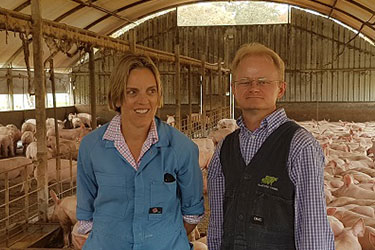 Piggery owner Edwina Beveridge (left) discusses measures being used to reduce antimicrobial resistance with Dr Mark Schipp (right).
Piggery owner Edwina Beveridge (left) discusses measures being used to reduce antimicrobial resistance with Dr Mark Schipp (right).An innovative piggery in Young, New South Wales, is leading the way in reducing antibiotics use without compromising the health and productivity of its stock.
Australia’s Chief Veterinary Officer, Dr Mark Schipp, visited the 2000-sow farm during November, as part of activities to mark Antibiotic Awareness Week, and said the piggery is a model for other producers to follow.
“Inappropriate use of antibiotic treatment can lead to strains of bacteria emerging, which don’t respond to current antibiotic treatment—this is known as antimicrobial resistance.” said Dr Schipp.
“Antimicrobial resistance is recognised as a growing threat to human and animal health, on a global scale, and by raising awareness we are reducing the threat to animal welfare, biosecurity and production.
Continue reading about young piggery leading the way in animal health management
“While Australia has one of the lowest levels of antibiotic use in animals, some use is required to maintain health and welfare. The threat of an antibiotic resistant bacteria emerging is very real.
“Antimicrobial stewardship is a collective set of strategies to improve the safe and appropriate use of antimicrobials and reduce the incidence of antimicrobial resistance.
“In Australia, both the human and animal health sectors are collaborating with food and agricultural industries to develop antimicrobial stewardship strategies.
“The piggery I visited has taken an approach to managing animal health through nutrition, biosecurity measures and using vaccines to control infectious diseases in livestock.
“This model has been duplicated in other parts of the world, demonstrating that Australia is a world leader in innovative and practical animal management strategies.”
Antibiotic Awareness Week takes place during November each year and is endorsed by the World Health Organization. The day acknowledges the global importance of this growing issue. The event encourages best practice for the general public, health workers and policy makers, to avoid further emergence and spread of antimicrobial resistance (AMR).
AMR occurs when bacteria, parasites, viruses or fungi adapt to protect themselves from the effects of antimicrobial drugs designed to destroy them. This means that antimicrobial drugs (e.g. antibiotics) that were previously used to treat or prevent infections may no longer work.
The Department of Agriculture and Water Resources was involved in several activities for Antibiotic Awareness Week 2017, including the launch of a single government website on AMR. This website has been launched in collaboration with the Department of Health, the department’s partner in implementing the National Antimicrobial Resistance Strategy 2015-2019.
For more information about AMR, visit the Australian Government’s Antimicrobial Resistance website .
The Cocos (Keeling) Islands get an unwanted visitor
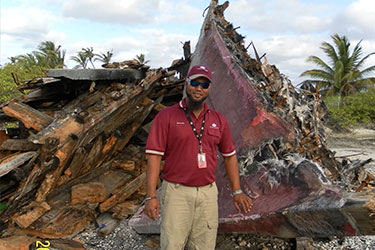 Cocos (Keeling) Island-based Biosecurity Officer Muhammed Azrin Des standing in front of the abandoned fishing vessel.
Cocos (Keeling) Island-based Biosecurity Officer Muhammed Azrin Des standing in front of the abandoned fishing vessel.Foreign fishing vessels in Australian waters present a range of potential biosecurity risks. They can carry unwanted exotic termites and borers deep within their woodwork—often undetected by the boat’s owners and crew. They can also harbour a range of hitchhiking pests that once in Australia threaten our agricultural industry, our environment and, ultimately, our way of life.
Recently, an abandoned fishing vessel washed up on the reef of West Island in the Cocos (Keeling) Islands, part of Australia’s Indian Ocean Territories. The Cocos (Keeling) Islands are some distance from mainland Australia—over 2,000 kilometres from the Western Australian coast and almost half-way between Australia and Sri Lanka. If an exotic species was to establish themselves on the islands it could be disastrous for the local environment.
The Indian Ocean Territories are rated as ‘international’ for both cargo and travellers, so any biosecurity threat that arrives on any of the islands may move to mainland Australia through the constant movement of people and goods. Because of this threat, the vessel was destroyed to mitigate any biosecurity risk.
Christian Sargent, Regional Ports Manager – West team, said that pieces of the vessel that washed up on the beach were returned to a collection point by members of the local community and Cocos (Keeling) Island-based Biosecurity Officer, Muhammad Azrin Des, managed the incident locally.
“With the cooperation of local residents, businesses and other Government departments, the vessel was successfully incinerated, eliminating any remaining biosecurity concerns,” Mr Sargent said.
Sharing knowledge to meet future biosecurity challenges
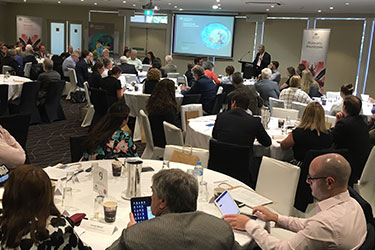
The Department’s Secretary Mr Daryl Quinlivan highlighted the growing biosecurity risks faced by Australia.
The National Biosecurity Forum, a joint meeting presented by the National Biosecurity Committee and the department, saw more than 100 participants in Canberra on 2 November 2017. A wide range of peak industry bodies, community, environment and research representatives attended.
Department Secretary Daryl Quinlivan provided the opening address, which highlighted the growing biosecurity risks we face as trade volumes increase and risk pathways change.
The Natural Resources Management (NRM) South presentation covered an extensive community engagement program operating in Tasmania helping protect the natural environment, agricultural and tourism sectors from biosecurity risks. Other sessions included presentations from organisations that have dealt with recent biosecurity challenges, including the Australian Banana Growers Council, Nursery and Garden Industry Australia and South Australian Oyster Growers.
Continue reading about sharing knowledge to meet future biosecurity challenges
The National Biosecurity Forum has been run by the department’s Biosecurity Policy and Response Branch since 2008. The sessions enable us to hear directly from our stakeholders about their experiences and concerns. They also give us the opportunity to highlight what the Australian Government is doing to support them. Important relationship building, collaborative problem solving and practical workshops also take place.
While some of the workshops and presentations raised issues and ideas previously discussed during biosecurity roundtables held in each state and territory, some new topics of national significance were raised.
One of the workshops sought input about the development of a National Biosecurity Statement. Further consultation on this is scheduled to take place during 2018.
You can find out more about the roundtable discussions, including what we are doing to support our stakeholders, by viewing the summary roundtable meeting reports on our website.
If you would like more information on the upcoming Biosecurity Roundtables or the National Biosecurity Forum, please call 1800 068 468 or email the Biosecurity Roundtable Secretariat.
Avian compound construction completed at Mickleham PEQ
The Stage 2 Build at the department’s Mickleham Post Entry Quarantine (PEQ) facility has now finished, with the completion of the avian compound. This compound is the final building at the PEQ facility to be completed, and it was handed over to the department on 14 December 2017.
With five Physical Containment Level 3 biocontainment units, the compound handles imported fertile eggs and live birds. This is the highest level of biosecurity containment of all the compounds at the Mickleham PEQ Facility.
When housing eggs and live birds, the biocontainment units in the avian compound will operate at negative pressure to reduce biosecurity risks. There are also a range of decontamination methods for moving people, equipment and consumables in and out of the biocontainment units during quarantine. These include showers for personnel, gaseous decontamination chambers, chemical dunk tanks and steam sterilisers.
Continue reading about Avian compound construction completed at Mickleham PEQ
The department has commenced running a series of rigorous tests to ensure the compound will maintain these strict levels of biosecurity containment, before imported eggs and live birds are allowed to undergo quarantine at the Mickleham facility. This process is known as operational commissioning.
PEQ Assistant Director Joanne Langkamp explained that while operational commissioning has occurred for all of the compounds at the Mickleham PEQ facility, the avian compound will have the longest testing period due to the complexity of the systems in this section.
“Some of this testing will involve housing and caring for local poultry and pigeons in the biocontainment units, and the department is working closely with industry during this part of the testing process,” Ms Langkamp said.
Once the Mickleham PEQ facility is fully completed in 2018, it will replace the remaining department’s previous quarantine facilities at Torrens Island in South Australia and Spotswood in Victoria.
You can follow the progress of the Mickleham PEQ facility’s construction and operational commissioning phases at the new Post Entry Quarantine Facility.
Latest app technology for Rangers
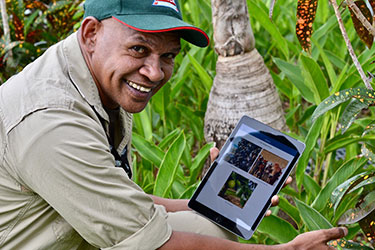 NAQS Community Liaison Officer Harry Tamwoy demonstrates the Ranger App.
NAQS Community Liaison Officer Harry Tamwoy demonstrates the Ranger App.Biosecurity data collection continues to improve with the development of a mobile application that makes recording information easier and efficient.
Biosecurity in northern Australia underpins development in the area and helps protect the entire country from pests and diseases that could devastate Australia’s $60 billion agricultural industries.
The department is working with 70 ranger groups across Australia’s 10,000 kilometres of northern coastline. The biosecurity reporting app, Ranger App, is available for use by rangers undertaking work for the department. Using the latest technology, it helps record information instantly.
The Ranger App is a mobile application that allows rangers to store surveillance data, even when they’re offline. This application is different from many others because rangers can enter their data directly into the system whilst out in the field. The data is then submitted when an internet connection to the device is restored.
Continue reading about latest app technology for Rangers
By reducing manual data entry, the app will reduce errors that result from double handling data and will also increase productivity.
Jonathan Benyei, Assistant Secretary for the department’s Science Services Group, said that the biosecurity Ranger App will make it easy to collect data in the field, and to capture photos, videos, GPS coordinates and GPS tracks, using one device and one application.
“The new app will allow the department to receive data in a timely manner and in a consistent format with all ranger groups. Faster delivery of data will mean faster detection and quicker responses to any biosecurity threats in Australia’s north,” Mr Benyei said.
The Ranger App is part of the Australian Government’s Agricultural Competitiveness and Developing Northern Australia white papers, the government’s plans for stronger farmers, a stronger economy and a safe, secure Australia.
A colourful discovery at Sydney airport
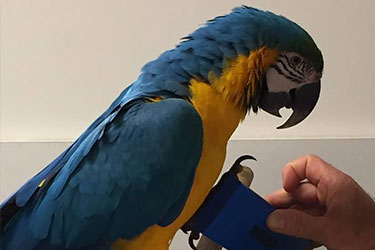 The macaw had spent 18 months travelling around 900 kilometres.
The macaw had spent 18 months travelling around 900 kilometres.A potentially serious biosecurity threat to Australia’s bird and human health was stopped when biosecurity officers discovered a blue and gold macaw at Sydney airport in December 2017.
After Sydney airport staff found the bird on the tarmac, they alerted Department of Agriculture and Water Resources staff, who contained it and referred it to a veterinary officer for assessment.
The veterinary officer found that the bird was in good health. While it had an identifying number on its leg band, there was no microchip to help track down its owner. The bird was held for supervision with strict biosecurity measures. These included isolation from other birds and decontamination procedures for the airport staff who came into contact with it.
While the initial signs pointed towards it being an Australian bird, which did not threaten our birdlife and health status, the task was to find conclusive evidence to ensure that it did not present a biosecurity risk to our valuable agricultural industries and environment.
Continue reading about a colourful discovery at Sydney airport
The department’s Social Media team reached out to the local community but could not find a match. After contacting the Department of Environment and Energy, our biosecurity officers were able to confirm through the leg band supplier that it was an Australian bred bird. Once this was confirmed, it no longer needed to be held under biosecurity control and it was transferred to the RSPCA.
It turned out that the macaw had escaped during April 2016 and spent the 18 months away travelling around 900 kilometres according to the bird’s breeder who contacted the department.
The department’s head of Biosecurity Operations, Nico Padovan, said illegal birds, or those accidentally imported as stowaways, may carry diseases, which can be transmitted to other birds and to people.
“This is a fantastic outcome, thanks to the cooperation, collaboration and information-sharing with external stakeholders,” said Mr Padovan.
“We take exotic bird finds very seriously. They can carry exotic highly contagious diseases such as Newcastle Disease and Avian Influenza, which can infect domestic poultry and many species of caged and wild birds—with some strains able to be transmitted to humans.”
“Safeguarding Australia’s biosecurity is our priority. This was a case where we did just that, and got this well-travelled macaw safely home.”
Parliament to consider enhancements to Biosecurity Act 2015
 Being able to respond more quickly to changes in biosecurity risk was a primary objective of the Biosecurity Act 2015.
Being able to respond more quickly to changes in biosecurity risk was a primary objective of the Biosecurity Act 2015.The Biosecurity Amendment (Miscellaneous Measures) Bill 2017, which will make some important enhancements to the Biosecurity Act 2015, is expected to be introduced in Parliament next month.
The Bill proposes amendments that:
- Enhance our ability to gather crucial information from importers when goods have been suspended, prohibited or released from biosecurity control
- Allow us to respond more quickly to changing biosecurity risks related to imported goods
- Make minor technical changes to improve administration of the Act.
A draft version of the Amendment Bill was released for a 60 day public consultation period that concluded at the end of January 2018. Feedback from that process will inform the final version of the Bill which, subject to inclusion in the March agenda, will be presented to parliament next month.
Continue reading about Parliament to consider enhancements to Biosecurity Act 2015
Being able to respond more quickly to changes in biosecurity risk was a primary objective of the Biosecurity Act 2015, which came into effect in June 2016. The changes proposed by the Bill are the final in a series of amendments that allow us to update import condition requirements as needed rather than through a formal legislative update process, which can be lengthy.
Import details that we may need to change from time to time, like lists of species of animals or plants that may be imported, are located on our website rather than being written into the legislation.
If the Bill is passed, we will be able to update these lists at any time as required. This allows us to be more responsive to emerging biosecurity risks by adjusting the goods to which certain conditions apply.
Changes commencing for fresh cut flowers and foliage in March, are an example of how we have identified ways to manage biosecurity risk more effectively and have changed our import conditions to match.
Changes to import conditions for fresh cut flowers and foliage
 The changes strengthen existing import conditions for fresh cut flowers and foliage.
The changes strengthen existing import conditions for fresh cut flowers and foliage.From 1 March 2018, importers will need to meet new alternative conditions to safely import fresh cut flowers and foliage into Australia. These strengthen existing import conditions, requiring these goods to be free of pests before being exported from their country of origin.
Transitional arrangements have been in force for importers to give them time to adjust to the new conditions.
This review of import conditions has been conducted under the Agricultural Competitiveness White Paper, strengthening biosecurity surveillance and analysis.
The primary source for legislative requirements for importing fresh cut flowers and foliage into Australia are the Biosecurity Goods Determinations, available on our website. Three new lists related to importing fresh cut flowers and foliage are also available on this page.
Read about importing fresh cut flowers and foliage into Australia safely.
Subscribe to the Import Industry Advice Notices message service for updates on changes to conditions for fresh cut flowers and foliage.
You can also register for a BICON account if you want to follow changes to cut flower import conditions. Information about how to follow a case is available at How do I use case options and case details.
Catch it. Call us.
 If BMSB established in Australia it could attack 300 types of plants.
If BMSB established in Australia it could attack 300 types of plants.Every year, September marks the start of Brown Marmorated Stink Bug (BMSB) season. This is when these offensive smelling bugs are likely to arrive in Australia on imported goods – usually on machinery from the USA and Italy.
This season has seen a change in their preferred means of travel and where they are coming from, with a spike in detections in goods arriving from Italy.
Peta Lane, head of the department’s Compliance Division said there had been a number of detections at the border, including dead and live bugs found at two sites in Western Sydney.
“We have strict import conditions in place for goods arriving from BMSB countries and each season we strengthen the measures according to the risk. Following the increase in detections and because we’ve found live BMSB we now require all goods arriving from Italy to be treated onshore or prior to export”, she said.
Continue reading about Catch it. Call us.
“Even though these measures will decrease the chances of live BMSB making it past the border it is important that anyone who transports or works around imported goods, keeps an eye out for these bugs - particularly if you unpack containers.”
Under the Biosecurity Act 2015 there is an obligation for people to report suspected exotic pests and diseases.
Ms Lane said importantly though, that one phone call could prevent a costly incursion and major damage to our food production industries. Ultimately, keeping these pests out of Australia benefits everyone.
If you find live or dead BMSB, or any other type of pest, there are few simple things you can do to help contain it:
- collect specimens for our entomologists (a scientist who studies insects) to diagnose
- re-seal any opened boxes or cartons
- re-pack the container and shut the doors
- do not move the container
- quickly phone the department’s See. Secure. Report. hotline on 1800 798 636.
Brown Marmorated Stink Bug adults range in length between 12-17 mm. They are mottled brown in colour, and have a shield shaped appearance. It looks similar to Australian native stink bugs but it is larger.
If BMSB were to establish in Australia we could expect it to attack 300 types of plants including nuts, grains, berries, cotton and citrus. It will also invite itself into your home or business premises in large numbers, looking for a sheltered place to spend the winter. In addition to their infesting behaviour they really do stink!
Find out more at outbreak.gov.au.
Border finds: An unwanted hitch-hiker sends us batty

The specimen was confirmed to be Glischropus aquilus, commonly known as a thick-thumbed bat.
A passenger arriving from Thailand at Melbourne International Airport recently got a surprise when airport staff discovered a live exotic bat attached to their suitcase. After finding the bat amongst a carousel of luggage arriving from Phuket, airport staff notified our biosecurity officers.
After the bat was euthanized by a departmental veterinarian, a tissue sample was sent to our Operational Science Services team for molecular analysis. Once identified, the specimen was confirmed to be Glischropus aquilus—commonly known as a thick-thumbed bat.
Little is known about this particular bat, as it was only described in 2015 based on a single bat found in Sumatra, Indonesia.
Exotic bats present a risk to human health and our natural environment because they can carry diseases fatal to humans including Nipah virus and Lyssaviruses. They can also carry White Nose Syndrome (WNS), which has caused the deaths of more than five million bats across North America.
Bats have important roles to play in Australian ecosystems in regard to pollination, seed dispersal and insect predation. Damage to our local bat population would have a significant impact on our natural environment.
Remember to check your luggage when packing for Australia. Clean any contaminated footwear, equipment or clothing.
For more information about protecting Australia from the world’s most severe pests and diseases, and protecting our unique environment, visit our page about travelling to Australia.
Border finds: Don't play Russian roulette with Australia's biosecurity

The seeds were collected from a botanic garden and individually bagged to grow in Australia.
Our vigilant biosecurity officers recently stopped a garden’s worth of biosecurity hazards from entering Australia when they intercepted several packages of seeds and live plants. The seizure was made during a search at Brisbane International Airport.
The passengers were searched after they caught the attention of detector dog, Heath, who alerted his handler to the couple’s luggage. The search revealed several plant seedlings with soil attached wrapped in plastic bags, as well as a number of different types of seeds that had been individually bagged and labelled. When examined, the bags were found to contain Kochia seed (Bassia scoparia), an invasive weed prohibited under federal and state legislation, amongst other high risk items.
When questioned, it turned out that the couple, who had arrived from Russia, were visiting their son and had collected the seeds from a botanic garden as a gift. The items were seized and destroyed, and the couple received an infringement notice. Our biosecurity officers also performed a subsequent visit to their relatives’ garden, to ensure that no Kochia seeds had been grown previously.
Imported soil, seeds and live plant material could introduce plant pests and diseases that damage Australia’s important agricultural industries, as well as our natural environment.
The department works diligently with airlines and the travelling public to enforce Australia’s strict biosecurity border controls. In the 2016-17 financial year, 158 million mail items and 20 million passengers were screened, along with the assessment of 18,000 vessels.
If you’re travelling overseas, it’s important to check that items comply with Australia’s biosecurity requirements before mailing them, or bringing them home in your luggage.
For more information, please go to Travelling or sending goods to Australia.
We Want Your Input

The department is currently seeking feedback on:
- Draft review of import requirements for fresh dragon fruit from Indonesia
- We are reviewing the marinepests.gov.au website so it will become easier to use and deliver the information our stakeholders need. We welcome feedback from various groups including recreational boaters, commercial vessel operators, divers, aquaculture farmers, aquariums, and those with an interest in the marine environment. The department has commissioned an independent research agency, Lonergan Research to review the website. If you are interested in participating in the user research as part of the website review, please complete the online survey.
See the latest Import industry advice notices or Export industry and market access notices.
